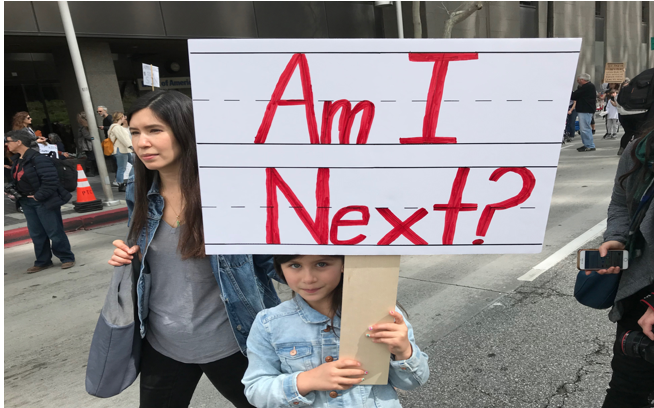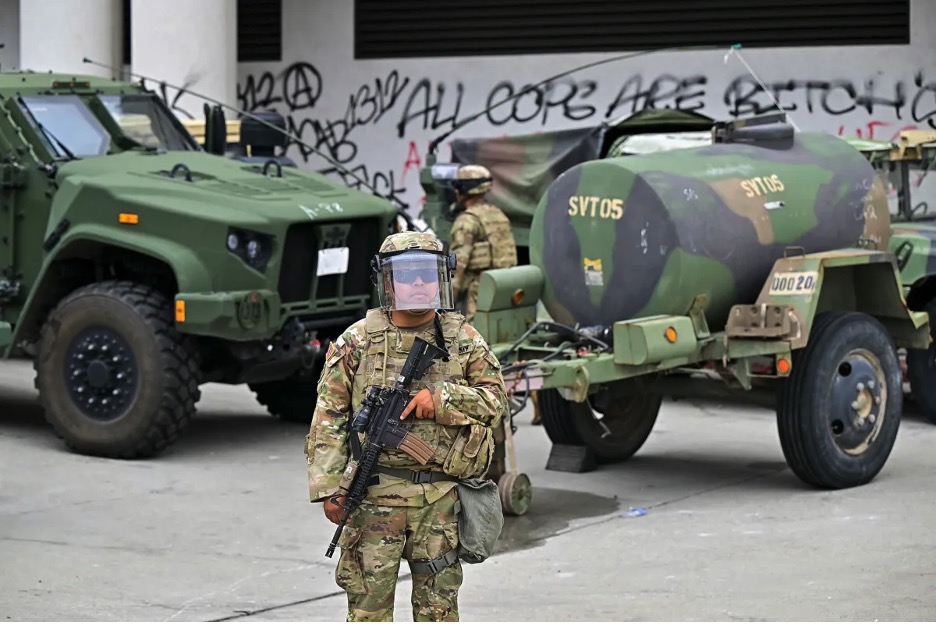CommentsGELFAND’S WORLD--I was a little concerned that the number of people showing up for the march against gun violence might be lower than expected. After all, it's been a month since the last mass shooting, and you know how the American people are always being accused of having a short attention span. Instead, the streets were packed and the rally area going from the City Hall to the Music Center was jammed.
 It's hard to estimate crowd sizes unless you are an expert. Were there as many people as it would take to fill the Rose Bowl? Clearly there were. Two Rose Bowls and the Coliseum? I don't know for sure, but it may have been.
It's hard to estimate crowd sizes unless you are an expert. Were there as many people as it would take to fill the Rose Bowl? Clearly there were. Two Rose Bowls and the Coliseum? I don't know for sure, but it may have been.
There were a lot of signs. One young girl held this one: "Am I the next?" One woman held a fairly large board that was covered with names in small script. It was the roll of the dead. There was a woman holding a sign saying, "My uterus is more regulated than guns."
But I think that the sign that will ultimately carry the greatest weight is the simple rendition of the words spoken by Emma Gonzalez a few days after her classmates were murdered in Parkland. As she scathingly recited the NRA's standard excuses for doing nothing, she said, "We call B.S."
That's the answer in a nutshell.
It's the answer to that moronic line, "Guns don't kill people, people kill people."
We call B.S. If you try to respond to the guns don't kill people argument, you realize that it is so preposterous that it barely merits a response, yet the NRA and its lackeys have been flogging this line for decades. Guns may do a lot of things, from punching holes in targets to defending farm animals from wolves, but one thing that they most definitely do is to kill people. But instead of rolling our eyes and trying to answer with facts and logic, we now have an answer: "We call B.S."
Christine Emba sums up the argument -- and explains a surprisingly strong national movement -- in the Washington Post. "We all know what guns are really for." Emba ticks off all the futile approaches -- banning bump stocks, raising the age for buying an AR15, arming school teachers -- as the evasions of reality that they are. "After all, what are guns really for? Guns are for killing."

So we come down to the fact that we've been banging our heads against a political brick wall for a long time. We wondered over the years how painful things would have to get before large numbers of people would make gun regulation a high priority item.
After all, the NRA and its followers have always been a minority of the electorate. It's just that they have made themselves into single issue voters, enough to nudge a Republican primary into hard-right territory and often enough to scare Democrats running in statewide races.
What was heartening was that the new generation isn't encumbered by those decades of failure. They understand that at a certain level, their lives are on the line, and that fact supercedes all the political experience that the older generations are laboring under.
Perhaps the NRA and the Republican Party are forgetting that it was the threat of being sent to fight and die in Viet Nam that inspired a lot of young men (along with their parents and their sisters) to protest in the 1960s. The analogy with our current situation is apt. The numbers are smaller, but the dead are right in front of us -- literally in front of the shooting survivors and through television and the internet for the rest of us.
What was also heartening was that the new generation has figured out that voting is important. In this sense, they are already a big step ahead of the Viet Nam generation. There were many individuals and groups carrying registration forms and offering to register people right there. There was a group called Head Count that has as its slogan Music Democracy Action. I don't know anything about their organization, but they seemed like nice people. Even the county Registrar Recorder had a table set up. That agency is working on a new system that will maintain a paper trail for all ballots combined with a quick electronic tally.
In addition, the office of California's Secretary of State was advertising the process of pre-registration to vote. If you are 16 or 17 years of age, you can pre-register and when you turn 18, the system will automatically mark you as eligible to vote. This is potentially useful for those who will be turning 18 between now and the November election.
The pro-gun side was there too, almost two dozen of them
Walking back from the big rally, I chanced to come across the small area set aside for the opposition. It was the same place that was used previously at the March for Science nearly a year ago. (The reader might wonder who would want to protest against science, but it was clear at the time that the March for Science was equally a march against Trump, so it wasn't too surprising that a few people with red caps would also show up at that time.)
 On this day of the March For Our Lives, I tried to count the opposition, but there were more police and volunteer crowd monitors protecting them than there were actual counter-demonstrators. I counted 20 of the opposition. Perhaps there were one or two more.
On this day of the March For Our Lives, I tried to count the opposition, but there were more police and volunteer crowd monitors protecting them than there were actual counter-demonstrators. I counted 20 of the opposition. Perhaps there were one or two more.
One of them was holding a sign with pictures of Mao, Stalin, and Hitler. The caption on the sign was that these dictators liked the idea of gun control, the implication being that an armed population is a deterrent to tyranny.
It is a difficult argument to refute, and I think that this topic needs to be dealt with by gun control advocates. Our Second Amendment refers directly to the security of a free State and we ought to address the issue of what a well regulated Militia really means.
I could be snide and point out that the twenty or so protestors were the ones who sounded most likely to sign on with a fascist dictatorship, but there is a legitimate point that is buried somewhere in the rhetorical murk. I would argue that the Second Amendment could be construed by modern society as allowing for ownership of bolt action rifles and perhaps even a revolver, but we ought to draw the line at allowing high powered automatic and semiautomatic rifles. In other words, the AR15 -- the favorite of mass murderers -- and everything else that carries the same firepower -- should not be in the hands of civilians. We could actually allow for a civilian Militia, provided that it is well regulated, which means in practice that it is under the control of state government.
But on March 24, the pro-gun folks were not there to discuss fine points of political doctrine. Perhaps one or two of them were, but when a small group like this is confined behind a line of police for their own protection, the chance for rational dialog is pretty minimal. The fact that the pro-gun group brought their own bullhorns also made it clear that this wasn't supposed to be an academic style debate.
In any case, the pro-gun side were outnumbered by about ten-thousand to one, a situation that was apparently replicated in other demonstrations around the country.
The Idea of Regulation at the Federal Level
Suppose we were to outlaw semiautomatic and automatic rifles in a way that would allow the ownership of bolt action rifles, revolvers, and perhaps semiautomatic pistols. How would that be managed? The answer is obvious if not entirely simple: In all other analogous cases, a federal agency develops proposals that are published for review and then, after an appropriate period for consideration, the final resulting rule set is enforced. We do it for radio waves (FCC Notice of Rule Making), for agricultural products (outlawing sale of beef from cattle with serious infections) and national security.
That's how regulation works in this country. We have it for banking, farming, pharmaceuticals, refineries, and most everything else that potentially creates a public hazard. The idea of creating regulatory agencies is necessary because a lot of things are complicated -- think about the process of determining that a new drug is both safe and effective.
A regulatory system created by congress also allows the lawmakers to avoid debates over what particular features define an assault weapon.
And the Usual Suspects were There Too
Any event that gets this much advance publicity, whether it be a street demonstration or a national political convention, attracts a few groups with other things on their minds. The March 24 activities were no exception. One fellow handed me a postcard proposing that California secede. On the bottom of the card, it read, "Sign the petition to vote and support California independence!" Actually the wording was in all-caps, but you get the idea. There were a couple of people pushing Green Party candidacies and a few people pushing for California to adopt a single payer health plan on its own. One fellow insisted that we continue to write in Bernie Sanders in future elections.
A Real Success
But mainly, there were thousands upon thousands of people who were not willing to wait until political Utopia is achieved before we can prevent future mass killings. They know who the opposition is, they understand the importance of replacing bad members of congress, and they understand the usefulness of public demonstrations as one element in creating a political wave.
(Bob Gelfand writes on science, culture, and politics for CityWatch. He can be reached at [email protected])
-cw
Tags: Bob Gelfand, Gelfand’s World, March for our Lives, Green Party, Bernie Sanders, guns, pro guns, anti guns, weapons, machine guns, automatic weapons,
















